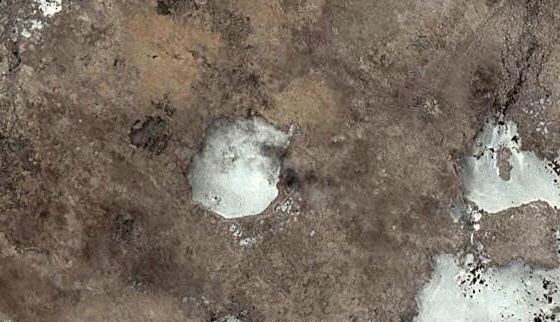Max. depth 3 m (9.8 ft) | Max. length 3.4 km (2.1 mi) | |
 | ||
Umm al Binni lake is a mostly dry lake within the Central Marshes in Maysan Governorate in southern Iraq. The 3.4 km wide lake is approximately 45 km northwest of the Tigris–Euphrates confluence. Because of its shape, location, and other details, it has been conjectured to represent an impact crater.
Contents
- Map of Umm al Binni lake Iraq
- Evidence as an impact crater
- Details and historical context
- Climate change and impact effects
- References
Map of Umm al Binni lake, Iraq
Evidence as an impact crater
Using satellite imagery, Sharad Master suggests the 3.4 km diameter dry lake may be an impact crater based on its nearly circular, slightly polygonal rim shape, and contrasting shape to other lakes in the region. As to its origin, he rules out karst topography, salt doming, tectonic deformation, and igneous intrusion as well as possible bombing or man-made origins. Some structures may initially be found through satellite remote sensing and later established as impact craters like the recently confirmed Santa Marta crater found by S. Master and J. Heymann.
Details and historical context
Master estimates the age of the crater to be less than 5000 years, or earlier than 3000 BCE, due to the deposition of sediments of the Tigris-Euphrates plain as a result of the 130–150 km seaward progradation of the Persian Gulf during that time period. A lack of writings describing this event by well-known authors like Herodotus (484–425 BC) and Nearchus (360–300 BC) or later historians implies the impact may have occurred earlier, or between 3000 and 5000 years BP. During this time period, the Al Amarah region was under the Persian Gulf at a depth of approximately 10 m. Impact-induced tsunamis would have devastated coastal Sumerian cities. This may provide an alternate origin of the 2.6 m sediment layer discovered during an excavation of the Sumerian city of Ur by Leonard Woolley in 1922-1934. Descriptive passages in The Epic of Gilgamesh (circa 1600–1800 BCE) may describe such an impact and tsunami, suggesting a link to the Sumerian Deluge:
...and the seven judges of Hell, the Annunaki, raised their torches, lighting the land with their livid flame. A stupor of despair went up to heaven when the god of the storm turned daylight into darkness, when he smashed the land like a cup. One whole day the tempest raged, gathering fury as it went, it poured over the people like tides of battle; a man could not see his brother nor the people be seen from heaven. Even the gods were terrified at the flood, they fled to the highest heaven, the firmament of Anu; they crouched against the walls, cowering like curs.
Climate change and impact effects
It has been proposed that sudden climate changes and catastrophic events around 2200 BCE (including the collapse of the Sumerian civilisation) could be linked to a comet or asteroid impact. Master has conjectured that the alleged Umm al Binni impact could be responsible for this catastrophe, producing the energy equivalent to thousands of Hiroshima-sized bombs.
Using equations describing impact effects based on work from Collins et al., Shoemaker, Glasstone & Dolanand others, Hamacher determined that an impacting bolide would have produced energy in the range of 190 to 750 megatons of TNT (for an asteroid and comet impact, respectively). For comparison, the Tunguska event was estimated to have an explosive force of about 10-15 megatons.
Hamacher's result is dependent on the impactor's density, size, and impact velocity. In order to produce an impact crater with the dimensions of Umm al Binni lake, a Ni-Fe asteroid (density = 7860 kg/m^3, v = 15 km/s) would have been between 90 and 110 m in diameter while a comet (density = 500 kg/m^3, v = 25 km/s) would have been between 200 and 300 m in diameter. The resulting impact effects would have caused massive devastation to an area thousands of square kilometres in size, but would not have been sufficient on its own to have caused the wide-scale damage seen at distances exceeding ~100 kilometers from the impact and thus could not be responsible for many of the more distant devastating effects on its own.
Although a large mount of circumstantial evidence has been published in the literature suggesting Umm al Binni is an impact crater, no on-site analysis has been done, primarily due to the current volatile and dangerous situation in Iraq. Therefore, Umm al Binni lake remains a possible, albeit unconfirmed, impact structure.
